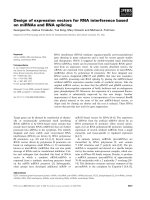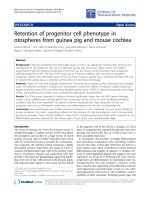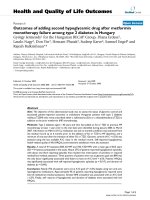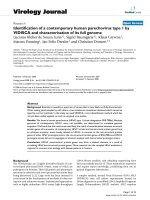Báo cáo hóa học: " Synthesis of High Coercivity Core–Shell Nanorods Based on Nickel and Cobalt and Their Magnetic Properties" pot
Bạn đang xem bản rút gọn của tài liệu. Xem và tải ngay bản đầy đủ của tài liệu tại đây (341.45 KB, 5 trang )
NANO EXPRESS
Synthesis of High Coercivity Core–Shell Nanorods Based
on Nickel and Cobalt and Their Magnetic Properties
T. N. Narayanan
•
M. M. Shaijumon
•
P. M. Ajayan
•
M. R. Anantharaman
Received: 25 July 2009 / Accepted: 2 October 2009 /Published online: 21 October 2009
Ó to the authors 2009
Abstract Hybrid magnetic nanostructures with high
coercivity have immense application potential in various
fields. Nickel (Ni) electrodeposited inside Cobalt (Co)
nanotubes (a new system named Ni @ Co nanorods) were
fabricated using a two-step potentiostatic electrodeposition
method. Ni @ Co nanorods were crystalline, and they have
an average diameter of 150 nm and length of *15 lm.
The X-ray diffraction studies revealed the existence of two
separate phases corresponding to Ni and Co. Ni @ Co
nanorods exhibited a very high longitudinal coercivity. The
general mobility-assisted growth mechanism proposed for
the growth of one-dimensional nanostructures inside nano
porous alumina during potentiostatic electrodeposition is
found to be valid in this case too.
Keywords Magnetic nanowires Á Nanorods Á
Hybrid nanostructures Á Core–shell nanostructures Á
Mobility-assisted growth mechanism
Introduction
Nanostructured materials such as nanowires, nanotubes and
nanorods are drawing considerable attention of the scien-
tific community because of their tremendous application
potential in various fields such as solar cells, field sensors,
bioseparation and medical therapy [1]. Designing and
controlling the morphology and growth of these nanowire
and nanotubes will surely impact the development of
nanotechnology [2, 3]. The landmark paper on carbon
nanotubes by Iijima [4] led to a surge in research activities
in the area of organic and inorganic one-dimensional
nanostructures [2]. Inorganic one-dimensional nanostruc-
tures like nanotubes and nanowires assume significance
because of their diverse utilities in sensor technology, high
density magnetic storage, delivery vehicles, catalysis and
selective separation [5, 6]. Various methods are in vogue
for the synthesis of metal nanotubes and nanowires. These
include various wet-chemical routes [5, 7–9] and physical
techniques such as electrochemical deposition, pulse laser
deposition and molecular beam epitaxy [10–12].
Metallic magnetic nanotubes/wires of Ni, Co and Fe and
also their alloys such as FePt, CoPt, NiFe, NiZn, CoCu and
FeB were investigated in great detail due to their application
potential in diverse fields such as perpendicular recording,
cell separation, diagnosis, therapeutics and magnetic reso-
nance imaging [2, 13–18]. Most of these structures are based
on pore wall modification or wet-chemical methods [12].
Magnetic nanostructures synthesized via the earlier-men-
tioned routes are often impure and rendered useless for
applications [2]. Template-assisted technique is an elegant
technique for fabricating one-dimensional structures, and
most of the reported template-assisted methods are based on
the chemical modification of porous templates such as
etched polymer membrane or anodized alumina (AAO).
Template-assisted electrodeposition is a simple, low-cost
and unique method for the preparation of one-dimensional
structures with very high purity and control [2].
Controlled synthesis of smart nanostructures based on
magnetic materials assumes important due to their potential
T. N. Narayanan Á M. R. Anantharaman (&)
Department of Physics, Cochin University of Science
& Technology, Cochin 22, Kerala, India
e-mail:
M. M. Shaijumon Á P. M. Ajayan
Department of Mechanical Engineering & Materials Science,
Rice University, Houston, TX, USA
123
Nanoscale Res Lett (2010) 5:164–168
DOI 10.1007/s11671-009-9459-7
applications in various fields and the possibility for
manipulating these structures using an external magnetic
field [19, 20]. Earlier, the authors reported the synthesis of
Nickel nanowires (Ni NWs), Cobalt nanowires (Co NWs)
[13] and Cobalt nanotubes (Co NTs) [2] employing dif-
ferent precursors by a single step potentiostatic electrode-
position technique. A general mobility-assisted growth
mechanism has been proposed for the growth of one-
dimensional nanostructures during electrodeposition for the
first time, and the veracity of the mobility-assisted mech-
anism inside porous alumina has been tested using different
precursors. Recently, the authors also tested the veracity of
mobility-assisted growth mechanism inside MWCNTs and
could fabricate co-axial multifunctional nanostructures of
MWCNTs and Co NTs [20].
Core–Shell nanostructures represent a novel class of
hybrid materials, where composition and microstructure
varies through the radial direction [1]. The Co–Ni system
is special due to the fact that the magnetic properties,
especially, its coercivity can be tuned by varying the Co
content [15]. Cobalt is known for its contribution in
modifying the magnetic properties because of its high
uniaxial anisotropy. However, this is more true in the bulk
and the magnetic interactions taking place at the interface
at Ni @ Co could be entirely different, where they are in
the nano regime. Several groups attempted to synthesize
various magnetic alloys using template-assisted electro-
deposition [14–17], and they achieved this by mixing the
electrolyte precursors in different compositional ratios.
The lacuna of such techniques is the unpredictability in
the magnetic properties such as coercivity of the resultant
one-dimensional structures after electrodeposition. Co-
axial hybrid magnetic structures synthesized via a two-
step electrodeposition technique can possibly surpass this
problem by controlling the deposition of one of the
components. It was shown earlier that a single-step tem-
plate-assisted electrodeposition method could be
employed for the fabrication of one-dimensional magnetic
nanostructures [2, 13]. The authors successfully fabricated
various multifunctional nanostructures and concluded that
a mobility-assisted mechanism is responsible for the
growth of such nanostructures [20]. Co nanotubes could
be fabricated using template-assisted growth and if these
structures can be employed as further template for elec-
trodeposition, systems such as Ni @ Co could be fabri-
cated. Such a method of preparation for hybrid magnetic
nanostructures was not found to be attempted earlier.
Moreover, the growth parameters can be easily optimized.
This paper reports the fabrication of such a one-dimen-
sional system namely Ni @ Co nanorods, which is
essentially a core–shell architecture (Ni as core and Co as
shell) and studies on their structural and magnetic
properties.
Experimental
Alumina membranes (AAO template, Whatman) of high
purity and uniform pore density, with average pore diam-
eter *150 nm and thickness *60 lm, were employed for
electrodeposition. Initially, a layer of Ag (about 200 nm
thickness) was thermally evaporated onto one side of the
AAO template which acted as the working electrode for the
electrochemical deposition. The electrodeposition was
carried out on the nanopores, using a standard three elec-
trode potentiostat system (Princeton E.G & G 273 A). Ag/
AgCl was the reference electrode, and platinum was used
as the counter electrode. 0.2 M Cobalt acetate was used as
the precursor for electrodeposition for making cobalt
nanotubes, and the deposition was carried out for a time
period of 1 h. Ni NWs have been electrodeposited in to
these Co NTs using 0.2 M nickel sulfate hexahyrate
(NiSO
4
Á6H
2
O) in 0.1 M Boric acid (H
3
BO
3
) as electrolyte
for 1 h. Schematic diagram showing the synthesis of Ni @
Co nanorods is depicted in Fig. 1. The X-ray diffraction
(XRD) pattern of the Ni @ Co nanorods embedded in
alumina template was recorded using Cu Ka radiation,
k = 1.5418 A
˚
(Rigaku Dmax-C). Field Emission Scanning
Electron Microscope (JSM-6335 FESEM) was employed
to study the morphology of Ni @ Co nanorods. Individual
nanorods were separated by etching out the alumina using
3 M sodium hydroxide (NaOH) solution and decanting the
dissolved alumina using magnetic separation. Magnetiza-
tion measurements were carried out using a SQUID mag-
netometer (MPMS-5S XL Quantum Design) by keeping
the nanorods inside the alumina pores in order to retain the
alignment intact. Transmission electron microscopy (TEM)
experiments were performed using JEM 2010 transmission
electron microscope.
Results and Discussion
The formation of Co NT and the subsequent formation of
Ni NW inside Co NT (Fig. 1) are consistent with the
Fig. 1 Schematic diagram showing the synthesis of Ni @ Co
nanorods
Nanoscale Res Lett (2010) 5:164–168 165
123
mobility-assisted growth mechanism proposed earlier by
the authors on nanoporous alumina [2, 13]. There we could
synthesize Co NTs having very high coercivity and high
aspect ratio using cobalt acetate as precursor for electro-
deposition and Ni NWs of high crystallinity and aspect
ratio using nickel sulfate hexahydrate as precursor. It is to
be note worthy that testing the veracity of this mobility-
assisted growth mechanism for other porous membranes
such as metallic membrane is being attempted for the first
time. In generalizing this mobility-assisted growth mech-
anism, it is to be concluded that mobility of the cation and
hydration layer are important parameters determining the
morphology of one-dimensional structure after electrode-
position. Figure 2a shows the TEM of Co NT synthesized
using Cobalt acetate. TEM of Ni NW is shown in Fig. 2b,
and the inset depicts the electron diffraction (ED) pattern of
Ni NWs.
High crystallinity of Ni NWs is evident from the ED
pattern, and the formation of face-centered cubic (fcc) Ni is
also verified. Figure 2c depicts the FESEM images of Ni @
Co nanorods. Co NTs have been electrodeposited inside
AAO membrane using Cobalt acetate as described earlier
for 1 h, and then Ni is electrodeposited using NiSO
4
Á6H
2
O
also for 1 h. This has resulted into Ni-filled Co nanotubes
(Ni @ Co nanorods) of length 15 lm and of diameter
*150 nm. The formation of a core–shell nanostructure with
Co NT as shell and Ni NW as core is abundantly clear from
the TEM image (Fig. 2d). It is to be noted that from the TEM
image, some portion of the Co NTs remain unfilled. It can
also be seen from the top portion of the FESEM image
(Fig. 2c) that Ni is not completely filled inside Co NTs. The
growth of nanowires/nanotubes initiates from the bottom
portion of the alumina template. The incomplete filling of Ni
may be due to the difference in the growth rate between Ni
and Co, as their precursors are being different. Moreover,
the extra hydration layer in Ni ions also may reduce the
mobility and in turn the growth rate. This has supporting
evidence from the energy dispersive spectroscopy (EDS).
The compositional analysis of these nanorods has been
carried out using EDS and is shown in Fig. 3.
Fig. 2 a TEM image of Co NT, b TEM image of Ni NW (inset: ED of Ni NW), c FESEM image of Ni @ Co nanorods, and d TEM image of Ni
@ Co nanorod, after removing the alumina membrane
166 Nanoscale Res Lett (2010) 5:164–168
123
The presence of Co and Ni is evident from the EDS.
Small amount of silver (Ag) is detected here which are
perhaps from the back coating, which served as the
working electrode during electrodeposition. It is also clear
from the EDS that atomic percentage of Ni is less than that
of Co. XRD (Fig. 4) indicates that Ni @ Co core–shell
structure is crystalline in nature and constitutes two sepa-
rate phases, a fcc belonging to Ni and a hexagonally closed
packed (hcp) Co.
Broad features appearing in the 15–35° 2h range arise
from the amorphous alumina. This is in agreement with the
earlier reports [21]. The phase formation is consistent with
our earlier reports on Co NTs and Ni NWs [2, 13]. In order
to investigate the magnetic properties of crystalline Ni @
Co nanorods, room temperature and low temperature (6 K)
magnetic properties of the Ni @ Co nanorods were con-
ducted using a SQUID magnetometer. Figure 5a and b
depict the room temperature and low temperature M(H)
curves of Ni @ Co nanorods measured parallel to the
nanorods.
The Ni @ Co nanorods display a room temperature
coercivity of 200 Oe. This coercivity is much higher than
the bulk coercivity values of both the Ni (H
c
= 0.7 Oe)
and Co (H
c
= 10 Oe) [22]. The enhanced coercivity in Ni
@ Co nanorods emanate from the enhanced shape anisot-
ropy. Li et al. reported [14] a similar coercivity value for
Co nanotubes synthesized via template-assisted synthesis;
however, the values were smaller than our earlier reports
on Co NTs of very high aspect ratio [2]. This is due to the
fact that the shape anisotropy of the samples mentioned in
the earlier report is much higher (aspect ratio of Co NTs is
*330) than that of the present (aspect ratio of Ni @ Co
nanorods is *100). The coercivity value for Ni @ Co
nanorods is higher than that reported for Ni NWs [12]
possessing a higher aspect ratio, and this is due to the
presence of cobalt. This indicates that one can tailor the
coercivity of these heterostructures by controlling the
aspect ratio as well as cobalt content. M(H) curve at 6 K
exhibit an enhanced coercivity of *380 Oe. This is much
higher than the other reported values of Co-based alloy
nanowires [15]. The enhancement in coercivity at low
temperatures is consistent with the monotonic increase of
uniaxial anisotropy constant with decreasing temperature,
with the basic assumption that the shape anisotropy is
independent of temperature for high aspect ratio tubes [23].
Similar to Co NTs [2], Co NWs and Ni NWs [13],
squareness ratio (M
r
/M
s
) of the Ni @ Co nanorods is small.
This may be due to the very high magnetic dipolar interrod
interaction. This type of hybrid magnetic system with
higher aspect ratio can render very high coercivity with the
higher contribution of shape anisotropy and higher coer-
civity hybrid nanorods can find applications in fields such
Fig. 3 EDS of Ni @ Co nanorods
Fig. 4 XRD pattern of Ni @ Co nanorods
Fig. 5 M(H) curves of Ni @ Co
nanorods; a at room temperature
b at 6 K
Nanoscale Res Lett (2010) 5:164–168 167
123
as data storage where a high coercivity is required. This
can be achieved by extending the electrodeposition for
longer deposition times and aspect ratio up to three times
(*330) that of the present value (*100), using the AAO
template of 60 lm thickness.
Conclusions
A novel magnetic nanostructure called Ni @ Co nanorods
with Ni NW as core and Co NT as shell was synthesized
using a two-step electrodeposition method. Structural
studies indicate the formation of Ni and Co in two phases.
Magnetic studies showed that Ni @ Co nanorods exhibited
high longitudinal coercivity, and they can find applications
in various fields where high coercivity is required.
Understanding the growth mechanism also opens possi-
bility for tuning the magnetic properties by extending the
electrodeposition for longer times to obtain very high
coercivity hybrid nanowires.
Acknowledgments TNN acknowledges the financial support
received from Interconnect Focus Center at Rensselaer Polytechnic
Institute, Troy, New York, USA. TNN thanks Council of Scientific
and Industrial Research, India for financial support in the form of
CSIR-SRF.
References
1. Z. Liu, D. Elbert, C.L. Chien, P.C. Searson, Nano. Lett. 8, 2166
(2008)
2. T.N. Narayanan, M.M. Shaijumon, P.M. Ajayan, M.R. Anan-
tharaman, J. Phys. Chem. C 112, 14281 (2008)
3. G.W. Meng, Y.J. Jung, A. Cao, R. Vajtaj, P.M. Ajayan, PNAS
102, 7074 (2005)
4. S. Iijima, Nature 354, 56 (1991)
5. J. Bao, C. Tie, Z. Xu, Q. Zhou, D. Shen, Q. Ma, Adv. Mater. 13,
21 (2001)
6. M. Steinhart, R.B. Wehrsphon, U. Gosele, J.H. Wendroff,
Angew. Chem. Int. Ed. 43, 1334 (2004)
7. T. Yanagishita, K. Nishio, H. Masuda, Adv. Mater. 17, 2241
(2005)
8. K. Nielsch, F.J. Castano, S. Matthias, W. Lee, C.A. Ross, Adv.
Engg. Mater. 7, 4 (2005)
9. W. Lee, R. Scholz, K. Nielsch, U. Gosele, Angew. Chem. Int. Ed.
44, 6050 (2005)
10. C.R. Martin, Science 266, 1961 (1991)
11. G.P. Heydon, S.R. Hoon, A.N. Farley, S.L. Tomlinson,
M.S. Valera, K. Attenborough, W. Schwarzacher, J. Phys. D
Appl. Phys. 30, 1083 (1997)
12. R. Sharif, S. Shamaila, M. Ma, L.D. Yao, R.C. Yu, X.F. Han,
M. Khaleeq-ur-Rahman, Appl. Phys. Lett. 92, 032505 (2008)
13. T.N. Narayanan, M.M. Shaijumon, L. Ci, P.M. Ajayan,
M.R. Anantharaman, Nano. Res. 1(6), 465 (2008)
14. D. Li, R.S. Thompson, G. Bergmann, J.G. Lu, Adv. Mater. 20,
1 (2008)
15. S. Talapatra, X. Tang, M. Padi, T. Kim, R. Vajtai, G.V.C. Sastry,
M. Shima, S.C. Deevi, P.M. Ajayan, J. Mater. Sci. 44, 2271
(2008)
16. X.Z. Li, X.W. Wei, Y. Ye, Mater. Lett. 63, 578 (2009)
17. C.U. Wu, H.L. Lin, N.L. Shau, J. Solid State Electrochem. 10,
198 (2006)
18. L. Fu, J. Yang, Q. Bi, W. Liu, Nanoscale Res. Lett. 4, 11 (2009)
19. F.S. Ou, M.M. Shaijumon, P.M. Ajayan, Nano. Lett. 8, 1853
(2008)
20. T.N. Narayanan, C.S. Suchand Sandeep, M.M. Shaijumon, P.M.
Ajayan, R. Philip, M.R. Anantharaman, Nanotechnology 20,
285702 (2009)
21. H. Cao, L. Wang, Y. Qiu, Q. Wu, G. Wang, L. Zhang, X. Liu,
Chem. Phys. Chem. 7, 1500 (2006)
22. S. Chikazumi, Physics of magnetism (Wiley, New York, 1964)
23. Y. Henry, K. Ounadjela, L. Piraux, S. Dubois, J.M. George,
Duvail Eur. Phys. J. B 20, 35 (2001)
168 Nanoscale Res Lett (2010) 5:164–168
123









